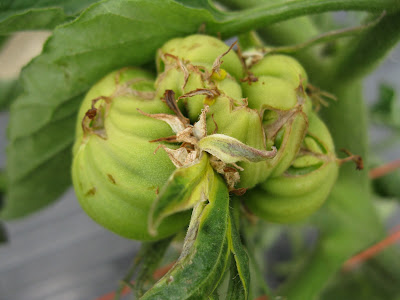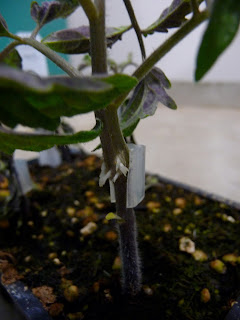 |
| Purpling on non-grafted Cherokee Purple at Blue Heron Farm |
Carol asked me to include some comments on my thoughts and feelings regarding the progress of my research. I enjoy gaining knowledge in plant pathology, although I still feel very overwhelmed and lacking in knowledge in this area. I am very excited for General Plant Pathology this coming semester. I enjoy being in the field much more than the lab. Thus, fruit quality analysis for my trials reflects data presented in peer-reviewed articles regarding grafted vegetables but does not go beyond that. I enjoy the opportunity to interact local growers and agriculture professionals. I enjoy working with and supervising the WSU NWREC Vegetable Horticulture staff to keep trials monitored and maintained.
I feel as if I can’t speak to where I would like to focus my research at this point in time. In the midst of the field season, I feel overwhelmed by the scope of my immediate research tasks. I get narrow-sighted, as I struggle daily to keep up with collecting quality data from my trials. I would like to collect plant samples from high tunnel-grown tomatoes throughout western Washington, but I don’t think I have the space in my schedule. It is difficult having so many trials over such a large geographical area, especially since my three crops require multiple harvests. I frequently feel as if I struggle to get everything done and organized, such that no one task gets completed in a thorough and quality manner.
1) Alan Schreiber On-farm field trials. Brian Koepke, an undergraduate student and intern through WSU stationed at Alan Schreiber’s farm, has been responsible for maintaining and monitoring the plots on a weekly basis. This includes clearly marking treatment plots, staking and trellising tomatoes, staking eggplants, pruning off rootstock re-growth, and monitoring for disease symptoms. Alan Schreiber does not prune tomatoes on his farm, so trial tomatoes have not been pruned making disease ratings difficulty.
a. Tomato.
 |
| On-farm trial at Schreiber and Sons Farm |
i. Disease Severity Rating. The tomato trials were observed to have developed purpling and rolling (dissimilar to ‘physiological leaf roll’). The incidence and severity of these symptoms were monitored and photographed three times a week by Brian Koepke until July 12.
ii. Plant Assays. Two samples of affected plants were collected during site visit on July 12. Leaves were put in a moist chamber for two days and assessed for late blight (Phytophthora infestans) with negative results. A Verticillium plant assay was also prepped for both plants.
iii. ELISA Virus Assays. Leaves from these two samples were also submitted to the WSU Prosser ELISA labs to be assessed for Tomato Mosaic Virus and Beet Curly Top Virus. Both samples tested negative for Tomato Mosaic Virus but one sample tested positive for Beet Curly Top Virus. I need to do further research on Curly Top virus and host insects.
Eggplant.
 |
| Grafted eggplant trial at Schreiber and Sons Farm. |
i. Disease Severity Rating. The trial was photographed and rated for disease and vigor on July 12, 2010.
ii. Verticillium Plant Assay. On June 22, twenty samples were collected from symptomatic plants in Alan’s eggplant field. These were rated by Debbie Inglis on July 15. Verticillium was not confirmed in any samples. Questionable samples were plated onto PDA. One plate yielded possible Verticillium. This was transferred onto NP10 and will be observed again in August.
Hermiston Watermelon Trials
 |
| Chlorotic watermelon leaf sample being prepared for moist chamber. |
Sam Pollock On-farm Trial.
 |
| On-farm grafted watermelon trial at Sam Pollock's leased field |
i. Disease Severity Rating. The trial was photographed and rated for disease and vigor on July 12, 2010. Sam Pollock has leased this field outside Hermiston. He has provided me with 2005-2010 crop history, 2009 chemical applications, and 2010 chemical applications.
ii. Stem diameter data. On July 19, Brian Koepke measured stem diameters of watermelon. Stem diameters were measured with a tape measure instead of a caliper, so they may be inaccurate. Stem diameters will be measured three times throughout growing season. If Brian’s measurements differ greatly from caliper-measured diameters, the July 19 data may have to be thrown out.
Hermiston OSU REC Trial.
 |
| Rating disease severity on grafted watermelon trial at OSU Hermiston Research Station |
i. Disease Severity Rating. Trial was rated for disease symptoms, physical defects, vigor and other visible symptoms on July 12, 2010. Syngenta-grafted plants are ‘Strong Tosa’ rootstock with cv. Melody instead of cv. Crisp’n Sweet. Grafting clips were left on Syngenta grafts and our weak plants. Some clips did not pop off as plant grew, compromising vigor and stem diameter.
ii. Stem diameter data. Later in July, Brian Koepke measured stem diameters of watermelon. Stem diameters were measured with a tape measure instead of a caliper, so they may be inaccurate. Stem diameters will be measured three times throughout growing season. If Brian’s measurements differ greatly from caliper-measured diameters, data may have to be thrown out.
Mount Vernon Field Trials.
Irrigation was increased in mid July to induce Verticillium (see specific details below). . From July 20-23, irrigation was increased for a total of 1.6 inches. Following July 23, Irrigation rates were returned to an average rate of 0.5 inch every 9-10 days. Photograph documentation consists of an overview photo, a photo of each repetition, and a photo of each treatment plot in one repetition.
Eggplant.
i. Disease Severity Rating. Eggplant have been monitored and photographed weekly at 8am on Wednesday or Thursday. Physical symptoms are photographed and rated for incidence and severity.
ii. Pesticide Applications. Aphids have been observed and plants have been treated with Pyganic.
Tomato.
i. Disease Severity Rating. The trial has been monitored and photographed weekly at 8am on Wednesday or Thursday. Physical symptoms are photographed and rated for incidence and severity.
ii. Pesticide Applications. Aphids have been observed and treated with EnTrust and Pyganic. Physiological leaf roll is effecting all plants in trial with no observed treatment difference and >50% severity in most plants.
iii. Trial maintenance. Tomatoes are pruned weekly and trellised as needed.
Watermelon.
i. Disease Severity Rating. The trial has been monitored and photographed weekly at 8am on Wednesday or Thursday. Although slow-growing in the cool weather, plants remain extremely healthy. Currently, the only physical defect is slight damage to the leaf cuticle caused by windburn and cold damage on older leaves from original transplants.
PPath C3 Inoculated Field Tomato Trial.
i. Disease Severity Rating. Trial is monitored and pruned weekly at 8am on Thursday or Friday. It is being trellised as needed.
ii. Irrigation. Irrigation rate was increased to 1” per week on July 20, 2010. From June 21-July 21, 2010, trial was irrigated twice weekly with a 2 gallon watering can at an approximate rate of 0.353 inches per plant. Irrigation rate will be decreased once plants set fruit.
iii. Verticillium Soil Assay. Soil samples were collected on July 21, 2010 for a soil assay to determine inoculum levels of Verticillium in plots. 9 cores were taken from each plot at a depth of 2-4” and mixed together in plastic bags. Soil was dried for two weeks in open paper bags under a fume hood. This soil assay will be conducted in August or September.
Blue Heron Farms.
i. Disease Severity Rating. 19 plants (10 Beaufort:Cherokee Purple and 9 non-grafted Cherokee Purple) at Blue Heron Farms were monitored and photographed on July 1 and July 23, 2010 . Non-grafted CP developed purpling on leaves.
ii. Treatments. On July 22, tomatoes were treated with a foliar application of compost tea for organic disease prevention.
4) Miscellaneous.
a. Plant Pathology. Kevin showed me how to use the NWREC autoclave and how to make NP10 media (required for the Verticillium soil assay). I also had a chance to look through Lindsey DuToit’s Verticillium collection with Debbie Inglis and Babette Gunderson. I watched the eOrganic webinar on late blight (Phytophtora infestans).
b. Certified Organic Field Harvest. I have been responsible for coordinating harvest in the certified organic field.
c. NARF Field Day. I gave a short presentation to approximately 100 people at the NARF field day about the grafting project. I also attended the NARF organic working group meeting.
d. Organic Certification Inspection. I participated in the organic certification inspection on July 14.
e. Viva Farms. I coordinated with Don McMoran to include graduate students and NWREC staff in a WSU Extension Staff tour of the Viva Farms Incubator Program on July 21. I also have been assisting Don McMoran and Sarita Schaeffer with tractor work at the farm as time in my schedule permits.
f. Lycopene Analysis. Jeremy Cowan and I continue to troubleshoot the University of Florida lycopene protocol. We are getting results that vary widely from the USDA Nutrient Analysis Lab data.
g. Fruit Quality Analysis. I’ve been working with other staff to finalize the harvest and fruit quality analysis protocols for the 2010 tomato harvest. I also continue to work on the eggplant and watermelon harvest and fruit quality protocols.
h. Grafting. Patti Kreider and I have been getting practice with hole insertion technique on butternut and watermelon starts.
i. Leica Stereomicroscope. I worked with Carol to purchase a dissecting scope for the Vegetable Horticulture lab following a generous donation by Craig McConnell.
GOALS FOR AUGUST
1. Verticillium soil assay. I hope to get soil plated onto NP10 before classes start on August 23.
2. Continue to collect data on field trials. I will continue monitoring for symptom severity and incidence on field plots. My goal is to observe on-farm trials at least three times. Stem diameters in watermelon were measured again on August 3, 2010. They will be measured a third time on August 17, 2010. Stem diameters will be measured weekly for watermelon at Mount Vernon beginning on August 10. Harvest data will be collected, as possible, at on-farm trials. Fruit quality data (Texture/firmness, soluble solids/Brix, and lycopene) will be collected three times throughout harvest. Following fruit harvest, destructive samples will be taken and plants will be assayed for Verticillium.
3. Literature review. Look at other thesis examples. Make an outline for lit review. Read at least three articles each week.













































